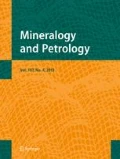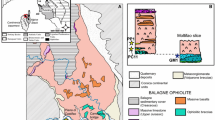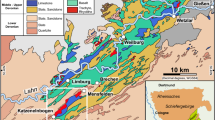Summary
A combined zircon typology, zircon Pb-Pb evaporation, and conventional U-Pb study of the late- to post-tectonic Rastenberg granodiorite yields the following results: Typological investigations show two distinguishable zircon populations. Type l: subtype S24 ofPupin, colourless to slightly pink, clear to turbid, often with cores, few to abundant inclusions, long prismatic; type 2: subtype S4 ofPupin, colourless to reddish or slightly pink, clear to slightly turbid, no visible cores, abundant inclusions, tabular habit, short prismatic.
At least 4 different zircon-forming events can be distinguished: Inherited cores with ages around 623±22Ma and single ages > 1206Ma from type 1 zircons imply the reworking of rocks derived from Cadomian and Proterozoic to Archean crust. Ages around 353±9Ma from type 1 zircons are interpreted as timing a first magma formation or the onset of a long-lasting magma-generating event during the Variscan plutonism in the South Bohemian pluton. The actual intrusion of the granodioritic magma into the middle crust took place around 338±2Ma (type 2 and rims of type 1 zircons).
Only type 1 zircons are found as inclusions in large K-feldspar phenocrysts providing evidence that these phenocrysts have grown before the 338Ma event and may be as old as 353 Ma.[⇃]
Zusammenfassung
Zirkon-typologische Untersuchungen, Einzelzirkon Pb-Pb-Evaporations- und konventionelle U-Pb-Altersbestimmungen an Gesteinen des spät- bis postkinematischen Rastenberger Granodiorits geben folgende Resultate: Typologisch lassen sich zwei Zirkonpopulationen unterscheiden: Typ 1: S24 Subtyp vonPupin, farblos bis leicht rosa, klar bis getrübt, häufig mit Kernen, wenige bis viele Einschlüsse, lang prismatisch; Typ 2: S4 Subtyp vonPupin, farblos bis rötlich oder leicht rosa, klar bis leicht getrübt, keine sichtbaren Kerne, viele Einschlüsse, flachtafeliger Habitus, kurzprismatisch.
Mindestens 4 unterschiedliche Altersgruppen lassen sich unterscheiden: Ererbte Kerne von Typ 1 Zirkonen mit Altern um 623±22Ma und einzelnen Altern > 1206Ma sprechen für die Aufarbeitung von Gesteinen, die von cadomischen und proterozoischen bis archaischen Gesteinen im Krustenbereich des Südböhmischen Plutons abstammen könnten. Alter um 353±9Ma von Typ 1 Zirkonen werden einer ersten magmatischen Phase oder dem Beginn der Krustenaufschmelzung im Zuge der Bildung der variszischen Plutonite zugeordnet. Die eigentliche Intrusion des Granodiorits um 338±2Ma wird mit Typ 2 und mit Randpartien von Typ 1 Zirkonen erfaßt.
In den großen K-Feldspat-Phänokristallen finden sich nur Zirkone vom Typ 1. Dies deutet darauf hin, daß die Phänokristalle vor dem 338Ma Ereignis gebildet wurden, eventuell also bis 353Ma alt sein können.
Similar content being viewed by others
References
Ansdell KM, Kyser TK (1991) Plutonism, deformation, and metamorphism in the Proterozoic Flin Flon greenstone belt, Canada: limits on timing provided by single-zircon Pb-evaporation technique. Geology 19: 518–521
Büttner S, Kruhl JH, Nega M (1994) Syn- to postmagmatic deformation in the Rastenberg granodiorite and its country rocks: an element of the late Hercynian development of the South Bohemian Pluton. Mitt Österr Miner Ges 139: 33–34
Conrad WK, Nichols IA, Wall VJ (1988) Water-saturated and under saturated melting of metaluminous and peraluminous crustal compositions at 10 kbar: evidence for the origin of silicic magmas in the Taupo Volcanic Zone, New Zealand, and other occurrences. J Petrol 29: 765–803
Da Costa LAM (1966) Structural evolution of the southern part of the Rastenberg pluton, Bohemian Massif, Lower Austria. Verh Geol B-A 1965: 75–76
Exner Chr (1968) Zur Rastenberger Granittektonik in Bereich der Kampwerke (Südliche Böhmische Masse). Mitt Geol Ges Wien 61: 6–39
Finger F, von Quadt A (1992) Wie alt ist der Weinsberger Granit? U/Pb versus Rb/Sr Geochronologie. Mitt Österr Miner Ges 137: 83–86
Finger F, Frasl G, Höck V, Steyrer HP (1989) The granitoids of the Moravian zone of Northeast Austria: products of a Cadomian active continental margin? Precamb Res 45: 235–245
Frank W, Hammer St, Popp F, Scharbert S, Thöni M (1990) Isotopengeologische Neuergebnisse zur Entwicklungsgeschichte der Böhmischen Masse: Proterozoische Gesteinsserien und Variszische Hauptorogenese. Österr Beitr Meteorol Geophys 3: 185–228
Friedl G, von Quadt A, Frasl G, Finger F (1992) Neue U/Pb Altersdaten aus der südlichen böhmischen Masse. Frankfurter Geowiss Arb Serie A 11: 217–218
Friedl G, von Quadt A, Finger F (1993) Erste Ergebnisse von U/Pb Altersdatierungsarbeiten am Rastenberger Granodiorit im Niederösterreichischen Waldviertel. Mitt Österr Miner Ges 137:131–143
Fuchs G, Matura A (1976) Zur Geologie des Kristallins der südlichen Böhmischen Masse. Jahrb Geol B-A 119:1–43
Gebauer D, Friedl G (1994) A 1.38 Ga protolith age for the Dobra orthogneiss (Moldanubian zone of the southern Bohemian Massif, NE-Austria): evidence from ion-microprobe (SHRIMP) dating of zircon. J Czech Geol Soc 39/1: 34–35
Gebauer D, Williams IS, Compston W, Grünenfelder M (1989) The development of the Central European continental crust since the Early Archean based on conventional and ionmicroprobe dating up to 3.82 b.y. old detrital zircons. Tectonophysics 157: 81–96
Grauert B, Hanny R, Soptrajanova G (1973) Age and origin of detrital zircons from the pre-Permian basements of the Bohemian Massif and the Alps. Contrib Mineral Petrol 40: 37–63
Kober B (1986) Single-zircon evaporation combined with Pb+ emitter bedding for207Pb/206Pb-age investigations using ion mass spectrometry, and implications to zirconology. Contrib Mineral Petrol 96: 63–71
Kober B (1987) Whole-grain evaporation for 207Pb/206Pb-age-investigations on single-zircons using a double-filament thermal ion source. Contrib Mineral Petrol 93: 482–490
Klötzli US (1993a) Einzelzirkon-207Pb/206Pb-Datierungen an Gestemen der südlichen Böhmischen Masse (Rastenberger Granodiorit, Weinsberger Granit). Mitt Österr Miner Ges 138: 123–130
Klötzli US (1993b) Single zircon evaporation ages from the Rastenberg granodiorite: new constraints on the magmatic evolution of the South Bohemian Pluton. Terra Abstr 1/5: 389
Klötzli US (1996) Zircon evaporation and conventional U-Pb analytical techniques at the geochronological laboratory, University of Vienna. Mitt Österr Geol Ges (in press)
Klötzli US, Parrish RR (1994a) Zircon Pb-Pb and U-Pb geochronology of the Rastenberg granodiorite (Lower Austria): evidence for the incorporation of Cadomian and possibly Archean crust into Variscan granitoids of the South Bohemian Pluton. Mitt Österr Miner Ges 139: 68–70
Klötzli US, Parrish RR (1994b) Evidence for the reworking of Cadomian crust in granitoids of Central Europe (South Bohemian Pluton, Bohemian Massif, Austria): a zircon Pb/Pb and U/Pb study. ICOG 8 USGS Circular 1107:175
Klötzli US, Koller F, Höck V (1995) Pre-Variscan remnant lower crustal rocks in Variscan granitoids of the South Bohemian Pluton (Bohemian Massif, Austria). Abstracts, EUG 8, Strasbourgh. Terra Abstr 7: 141
Koller F, Klötzli US, Höck V (1994) Indication of lower crustal origin for the Weinsberg granite (South Bohemian Pluton, Austria). J Czech Geol Soc 39/1: 55–56
Kröner A, Sengör AMC (1990) Archean and Proterozoic ancestry in late Precambrian to early Palaeozoic crustal elements of southern Turkey as revealed by single-zircon dating. Geology 18: 1186–1190
Kröner A, Wendt I, Liew TC, Compston W, Todt W, Fiala J, Vankova V, Vanek J (1988) U-Pb zircon and Sm-Nd model ages of high-grade Moldanubian metasediments, Bohemian Massif, Czechoslovakia. Contrib Mineral Petrol 99: 257–266
Kröner A, Hegner E, Jaeckel P (1994a) Pb-Pb and U-Pb zircon ages and Nd isotopic systematics for metamorphic rocks from the Gory Sowie block, western Sudetes, Poland, and geodynamic significance. J Czech Geol Soc 39/1: 60
Kröner A, Jaeckel P, Opletal M (1994b) Pb-Pb and U-Pb zircon ages for orthogneisses from eastern Bohemia: further evidence for a major Cambro-Ordovician magmatic event. J Czech Geol Soc 39/1: 61
Liew TC, Finger F, Höck V (1989) The Moldanubian granitoid plutons of Austria: chemical and isotopic studies bearing on their environmental setting. Chem Geol 76: 41–55
Ludwig KR (1992) Isoplot: a plotting and regression program for radiogenic-isotope data. USGS, Open-file report 91-445, pp 1–40
Müller B, Klötzli US, Flisch M (1994) Dating of the Silvretta older orthogneiss intrusion: U-Pb-zircon data indicate Cadomian magmatism in the upper Austroalpine realm. J Czech Geol Soc 39/1: 74–75
Müller B, Klötzli US, Flisch M (1995) U-Pb and Pb-Pb zircon dating of the older orthogneiss suite in the Silvretta nappe, eastern Alps: Cadomian magmatism in the upper Austro-Alpine realm. Geol Rundsch 84: 457–465
Parrish PP, Roddick JC, Loveridge WD, Sullivan RW (1987) Uranium-lead analytical techniques at the geochronology laboratory, Geological Survey of Canada. Geol Surv Canada Paper 87-2: 3–7
Peindl P, Höck V (1993) U-Pb and207Pb/206Pb-dating of zircons from the Habach formation (Central Tauern, Window; Austria). Terra Abstr 1/5: 392–393
Pupin JP (1980) Zircon and granite petrology. Contrib Mineral Petrol 73: 207–220
Roddick JC (1991)207Pb/2 06Pb dating by zircon evaporation: mechanisms of Pb loss. EOS 72/44: 531
Scharbert S (1987) Rb-Sr Untersuchungen granitoider Gesteine des Moldanubikums in Österreich. Mitt Österr Miner Ges 132: 21–37
Schenk V, Todt W (1983) U-Pb Datierungen an Zirkon und Monazit der Granulite im Moldanubikum Niederösterreichs (Waldviertel). Fortsch Mineral BH 61: 160–161
Schulmann K, Melka R, Holub F, Venera Z (1994) The mechanism of emplacement of Trebic durbachite massif based on petrofabric study. Mitt Österr Miner Ges 139: 111–112
Tuttle OF, Bowen gnNL (1958) Origin of granite in the light of experimental studies in the system NaAlSi3O8-KAlSi3O8-H2O. Geol Soc Am Mem 74: 153p
Van Breemen 0, Aftalion M, Bowes DR, Dudek A, Misar Z, Povondra P, Vrana S (1982) Geochronological studies of the Bohemian massif, Czechoslovakia, and their significance in the evolution of Central Europe. Trans R Soc Edinburgh 73: 89–108
Vellmer C (1992) Stoffbestand und Petrogenese von Granuliten und granitischen Gesteinen der südlichen Böhmischen Masse. Thesis, University of Göttingen, 112p
Von Quadt A, Finger F (1991) Geochronologische Untersuchungen im österreichischen Teil des Südbohmischen Batholiths: U-Pb Datierungen an Zirkonen, Monaziten und Xenotimen des Weinsberger Granits. Eur J Min 3 Bh 1: 281
Wendt JI, Kröner A, Fiala J, Todt W, Fiala J, Rajlich P, Liew TC, Vanék J (1992) U-Pb zircon ages and Nd whole-rocks systematics for Moldanubian rocks of the Bohemian Massif, Czechoslovakia. 1st International Conference on the Bohemian Massif, Prag 1988. Czech Geol Surv: 346
Wendt JI, Kröner A, Fiala J, Todt W (1993) Evidence from zircon dating for existence of approximately 2.1 Ga old crystalline basement in southern Bohemia, Czech Republic. Geol Rundsch 82: 42–50
White AJR, Chappell BW (1976) Ultrametamorphism and granitoid genesis. Tectonophysics 43: 7
Zoubek V (1988) Precambrian in younger fold belts, European Variscides, the Carpathians and Balkans. Wiley, New York pp 1–37
Zwart HJ (1986) The Prevariscan basement in the European Variscan belt. In:Freeman R, et al. (eds) Proceedings “Third EGT Workshop” ESF: 25–31
Author information
Authors and Affiliations
Additional information
With 6 Figures
Rights and permissions
About this article
Cite this article
Klötzli, U.S., Parrish, R.R. Zircon U/Pb and Pb/Pb geochronology of the Rastenberg granodiorite, South Bohemian Massif, Austria. Mineralogy and Petrology 58, 197–214 (1996). https://doi.org/10.1007/BF01172096
Received:
Accepted:
Issue Date:
DOI: https://doi.org/10.1007/BF01172096




